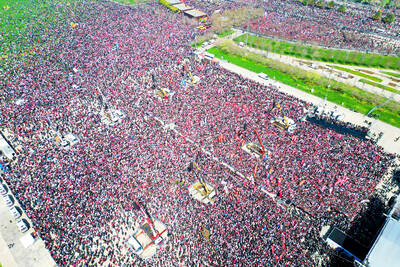When Saloni Singh was little, she would beg, then brawl with her brother for a turn on his video games. Her mother would broker peace by handing Singh a story book.
“It’s our Indian culture. Girls don’t play games,” Singh said.
Fast forward to adulthood and Singh now works remotely as a software engineer for a big US university, adding an extra 50 to 60 percent to her already high earnings playing video games by night.

Photo: REUTERS
Singh’s success comes as India’s US$1.5 billion gaming industry grows rapidly and opens up — slowly — to a generation of women and girls who play, earn and even date via video games.
However, female players say they face a barrage of abuse when they talk to fellow gamers online, with rape threats a daily hazard.
Add to that abuse the vastly lower prizes offered in female tournaments, and gamers and industry experts say the e-playing field is far from fair, despite all the gains made.
“Women are carving out a space for themselves in an industry that has traditionally been dominated by men,” said Salone Sehgal, founding general partner of Lumikai, a gaming-focused venture capital fund.
According to a recent report released by Lumikai, 43 percent of India’s 507 million gamers are female — the first year they have counted players by gender.
With 27.3 percent of India’s 1.4 billion population aged between 15 and 29, its gaming population is growing by 12 percent a year.
Cheap access to smartphones and the Internet has brought mobile games to India’s masses and now their appetite is huge. Indians consumed more mobile games last year than players in any other country, notching up a combined 15 billion downloads.
That has unlocked new revenue opportunities for female gamers, particularly in the competitive e-sports world, experts have said.
E-sports — which gained huge new popularity during COVID-19 lockdowns — refers to competitive gaming, where players train, win sponsorship deals and play in global tournaments.
The percentage of female players in competitive e-sports has risen from 12 percent in 2020 to 22 percent last year, according to the Federation of Indian Chambers of Commerce and Industry.
After decades of campaigning for recognition as a mainstream sport, India’s gaming industry last year broke away from other online games such as poker, which is banned in some states that want to crack down on gambling.
Competitive gamers chase the same sort of fame and fortune enjoyed by cricket and tennis stars through international tournaments and lucrative brand sponsorships.
However, the gains have largely gone to male players.
According to the Esports Federation of India, women can win about US$1,200 at a tournament, whereas open tournaments — which are dominated by male teams — offer prizes 100 times bigger.
Yet there are gains to be won beyond the cash, said Sehgal, even as women top up their prize money with streaming fees and brand sponsorships.
“Their increased visibility in the tech industry can help break down gender stereotypes and encourage more women to pursue careers in tech-related fields,” she said.
With more games featuring female protagonists, and plots that resonate strongly with women, she said the gaming industry was changing to include and encourage women players.
Khushveen Kaur is a 21-year-old e-sports athlete who plays for GodLike, a leading pro team. She started playing video games when she was six, and became a pro gamer at the age of 17.
When Kaur first started playing competitively, boys picked on her. However, as she got better, her peers took note. Their appreciation and camaraderie helped her overcome depression.
“I became more confident,” she said.
As she changed, so did her industry.
“People started organizing girls-only or women-only tournaments to push women forward, to create a safe space,” said Kaur, whose sole income is gaming, such is her success. “Three or four years ago, girls never got any opportunities. But I earn enough to live a good life.”
However, India’s female gaming boom has come at a cost.
When Singh turns on her microphone to say “Hello,” she is pelted with abuse. Rape threats and sexist taunts echo down her headphones as she parachutes to remote islands to slay enemies.
“It’s horrible the kinds of things men say. The worst things a girl can hear,” said Singh, who goes by the online moniker PlayLikeIncognito.
The level of online vitriol is high.
A survey this year by Local Circles — a community social media platform — found that eight in 10 urban Indian women use the Internet and 86 percent of them expressed concerns about being trolled, harassed, abused or subjected to cybercrimes.
In 2021, Singh was asked to lead an all-girl team in an online tournament with a prize pool of about US$122,300.
Instead of celebrating the tournament’s first all-girl team, the people streaming the tournament called them “free kills” — or easy targets, she said.
The female players were also derided as a “reservation” — India’s term for a quota to bolster marginalized groups.
“My DMs [direct messages] filled up with hate,” she said. “All these keyboard warriors... I just didn’t want to play.
Lokesh Suji, director of the Esports Federation of India, said there was work still to be done.
He said the industry tries to stamp out abuse and that he would like to see women grow as rich as the top men in gaming.
However, ultimately, Suji said: “Its our culture — we don’t really encourage girls to play.”

A fire caused by a burst gas pipe yesterday spread to several homes and sent a fireball soaring into the sky outside Malaysia’s largest city, injuring more than 100 people. The towering inferno near a gas station in Putra Heights outside Kuala Lumpur was visible for kilometers and lasted for several hours. It happened during a public holiday as Muslims, who are the majority in Malaysia, celebrate the second day of Eid al-Fitr. National oil company Petronas said the fire started at one of its gas pipelines at 8:10am and the affected pipeline was later isolated. Disaster management officials said shutting the

US Vice President J.D. Vance on Friday accused Denmark of not having done enough to protect Greenland, when he visited the strategically placed and resource-rich Danish territory coveted by US President Donald Trump. Vance made his comment during a trip to the Pituffik Space Base in northwestern Greenland, a visit viewed by Copenhagen and Nuuk as a provocation. “Our message to Denmark is very simple: You have not done a good job by the people of Greenland,” Vance told a news conference. “You have under-invested in the people of Greenland, and you have under-invested in the security architecture of this

Japan unveiled a plan on Thursday to evacuate around 120,000 residents and tourists from its southern islets near Taiwan within six days in the event of an “emergency”. The plan was put together as “the security situation surrounding our nation grows severe” and with an “emergency” in mind, the government’s crisis management office said. Exactly what that emergency might be was left unspecified in the plan but it envisages the evacuation of around 120,000 people in five Japanese islets close to Taiwan. China claims Taiwan as part of its territory and has stepped up military pressure in recent years, including

UNREST: The authorities in Turkey arrested 13 Turkish journalists in five days, deported a BBC correspondent and on Thursday arrested a reporter from Sweden Waving flags and chanting slogans, many hundreds of thousands of anti-government demonstrators on Saturday rallied in Istanbul, Turkey, in defence of democracy after the arrest of Istanbul Mayor Ekrem Imamoglu which sparked Turkey’s worst street unrest in more than a decade. Under a cloudless blue sky, vast crowds gathered in Maltepe on the Asian side of Turkey’s biggest city on the eve of the Eid al-Fitr celebration which started yesterday, marking the end of Ramadan. Ozgur Ozel, chairman of the main opposition Republican People’s Party (CHP), which organized the rally, said there were 2.2 million people in the crowd, but